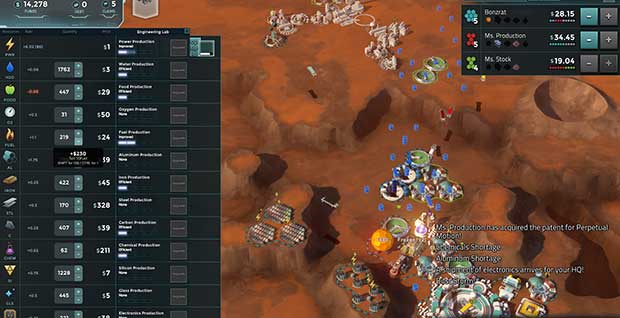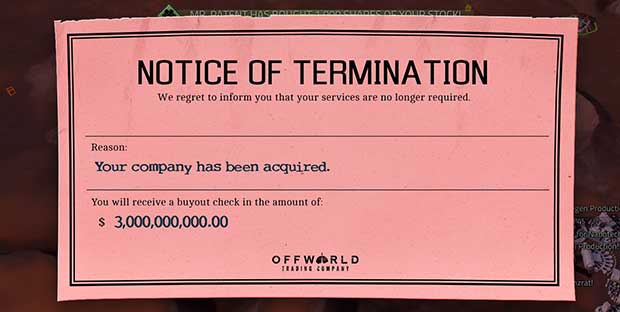Early Impressions: Offworld Trading Company
SPACE BUSINESS
Offworld Trading Company is a combat-free, sci-fi real-time strategy game from the lead designer of the sumptuous Civilization IV.
A great concept with a great pedigree – can it possibly be as good as it sounds? But enough about Snickers More Nuts, let’s talk about Soren Johnson’s new game, an Early Access version of which was released this week.
You’re in charge of a newly-founded corporate spacebase on Mars, which must expand, harvest, buy and sell resources in order to expand further – so far, so familiar. The key difference from the build’n’bash norm is that you don’t create any units. The only moving entities in the game are automated craft which shuttle resources from their various mines and generators back to your headquarters. Your primary job is to watch the numbers (which show the various types of resources you have, and more important their in- and outgoings), and place new buildings on the tiles which will speed up the acquisition of said numbers.
Rival corporations are doing the same, and in the earlier stages of the game you’re trying to place structures on the most resource-rich areas of the planet before they’re snatched by the others. New buildings, building permits and upgrades are bought with certain and varying types of resources, but you can always buy in a resource you don’t have with spare cash. Essentially what you’re doing is making sure you’re obtaining more of most resources than you need to spend, and building is a reaction to monitoring that rather than the key activity. Monitoring the likes of how much carbon you’re mining, how much water you’re using, how much power you’re selling is your primary focus.
The problem with this is that, well, I am spending a huge amount of my time with the game watching the numbers, which are concentrated into a vertical strip down the left hand side of the screen. The remaining 7/8ths or so of the screen, where all the pretty building is happening, barely gets a look in. I go over to it when I have to place a new building, but that takes a second, after which my head snaps back to that left hand bar and stares unblinkingly at it, waiting to see the effects on whatever resource I’ve just allocated a new construction to or worrying about how to make another one increase.
That’s not inherently a bad thing, as so far I’m finding Offworld Trading Co to be an extremely compulsive and tense spreadsheet-balancing game, but partitioning the UI this way can make the ‘main’ screen feel like a bit of a waste. I can see that there’s lots of cute detail in there, as constructions construct and shuttles shuttle, but there’s no cause to actually watch this stuff other than for its own sake, and not even much opportunity to as I need to keep such a weather eye on my own personal stock market. When I do look at the main screen, I don’t look at it as an exciting space colony – I just look for the coloured icons which denote the specific type of resource I need more of, or that I want to temporarily subvert my opponents’ supply of, then I switch back to my numbers. (I should also mention that maximum zoom out is the only logical way to play OTC, but in the current build that murders my frame rate. Early Access is early access, though).
Things change somewhat in the late game. To start with, you’re trying to build up, to ensure a steady supply of every resource/number, or if there’s a few you can’t get or don’t need, such an excess of the remaining numbers that you can afford to buy in that which you don’t have. Your long term goal, however, is to buy out rival corporations who are also busily ripping every mineral they can out of this alien world. For that, you need a) lots and lots of money and b) to keep a steady eye on another set of numbers over on the far right of the screen, where you can see the share price of your rivals.
You need to match that before you can buy a chunk of their stock, but the longer you take there more the price will rise, as just like you the other corps are steadily building more and mining more, and becoming more valuable as a result. Except – and this is the stuff I’ll only get a true handle on after putting many more hours into OFC – there’s a bunch of stuff you can do to screw up everyone else’s share price. Put them in debt and their stock market value takes a hit. To put them in debt – well, now the main screen takes on a far more significant role. The black market menu (bottom right) allows me, at a high cost, to blow up or temporarily disable enemy tiles, briefly make them earn resources for me, disrupt shipments, and assorted skulduggery all designed to create a resource deficit.
Of course, the enemy has access to this too, and my carefully-built network of oxygen generators, carbon mines, glass factories and solar panels increasingly ends up being frozen, exploded, commandeered and otherwise disrupted on an increasingly regular, and often disastrous basis. It can be devastating to see (and hear) those effects, to see your bucket of profits rapidly turn to a deficit, to have to abandon your plans to build this or buy out a particular target’s stock. Just as devastating as fleet of tanks rolling up to your headquarters or a nuke dropped on your capital city.
For me, playing strictly against lower-level AI while I learn the ropes, the black market is something I don’t think about until fairly late in the game, but I can see that a more practiced player is going to be dabbling in this stuff as soon as possible, in order to stop their opponents drawing ahead of them or even from grabbing all the most resource-rich tiles. In other words, in time maybe I won’t be looking at that list of numbers on the left quite as much as I do now. Right now, I tend to have only a vague sense of what the enemy’s built and where, but to be skilled at this my head’s going to have to snap back and forth all over the map, building a regularly-updated mental map of exactly what’s going on with my foes, not just myself.
What I’m saying is that Offworld Trading Company starts off seeming fairly simple, and low-conflict, but escalates into something smart, complicated and tense. It might have no combat, but this is a true arms race. As the corporations tussle for prize tiles or sabotage key buildings at the worst/best moment, constantly leapfrogging each other for the highest stock value, that there are no guns matters not a bit: this might even be a more competitive strategy game than most anything with bullets in it.
There are other complexities I haven't mentioned too, such as manipulating the market to get a better price for anything you have an excess of, investing in a limited pool of patents with major financial buffs, or choosing from a variety of Corporations with different resource requirements for their buildings. I suppose that's the Civ IV heritage peeking through: a great deal of thoughtfulness, depth and nuance packed into something which feels entirely approachable.
It’s not without issues – performance is all over the shop on my system (GTX970 / Core i7 980x FYI), what I pray are placeholder voices are cringey, and while I know this is backseat driving I do wonder if the key list of numbers would be better presented in a way that didn’t involve quite so much staring at the left-hand eighth of my screen. At this stage of my learning I’d also benefit from being more easily/quickly able to tell exactly what each building is, as many aren’t hugely distinctive. In time that’ll be a less of an issue, but it’s probably not ideal to spend three minutes going ‘er, um, where.. what’ every time I want to cause a mutiny in a key enemy structure.
Early access. Not a review. Things will change. Looking good already. Under the surface of a game ostensibly about endless harvesting, there’s a hell of a lot going on, and the infrastructure for truly ‘fierce’ battles. Space might be the theme, but boardroom warfare is the heart of Offworld Trading Company. There’s a long way to go, but I think this is going to be something pretty special.














